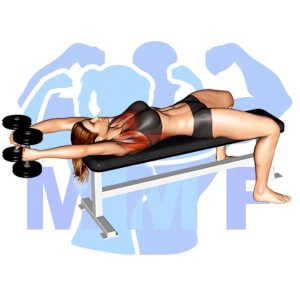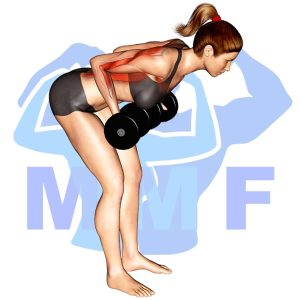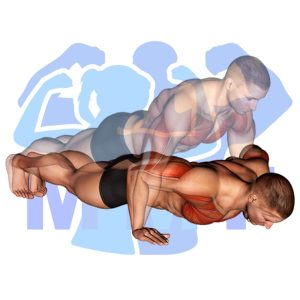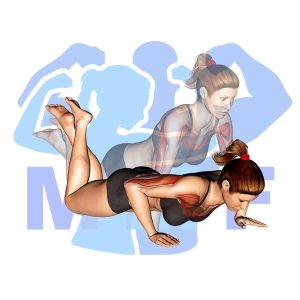Are you struggling to build a stronger back and shoulders with your current workout routine? Are traditional pull-ups and lat pulldowns not giving you the results you desire? If you answered yes, then you’re not alone. Many people face this same problem when it comes to their fitness journey. The good news is that there is a common cause for this struggle, and it’s usually due to not using the right equipment or technique. In this blog post, I will introduce you to the solution you’ve been looking for: resistance band pulldowns.
Resistance Band Pulldowns Summary
- Primary Muscles: Latissimus Dorsi
- Secondary Muscles: Biceps Brachii, Brachialis, Brachioradialis, Deltoid – Posterior, Infraspinatus, Levator Scapulae, Pectoralis Minor, Rhomboids, Teres Major, Teres Minor, Trapezius – Lower, and Trapezius – Middle
- Equipment: Resistance Band and Door Anchor
- Mechanics Type: Compound
- Force: Pull
- Utility: Basic

Resistance Band Pulldowns Instructions
- Attach the resistance bands to an anchor above head level.
- Grab the band handles and position so that there is a straight line from the anchor point to your hips that runs through the bands and your arms.
- Specifically, to make this straight line, you will need to bend at your waist. You are trying to simulate the motion of a pull-up, but instead, you are pulling down.
- Additionally, you could need to get down on your knees to get the correct range of motion under tension.
- Ensure the bands are tight with your arms extended.
- Then slowly pull the handles down to below your chin, similar to pulling your body up in a chin-up.
- Pause a moment under full contraction before slowly allowing the bands to extend your arms back straight.
- Repeat for your 8-12 reps.
Video Tutorial
Resistance Band Pulldowns Muscles
Target (Agonist)
Synergists
- Biceps Brachii
- Brachialis
- Brachioradialis
- Deltoid – Posterior
- Infraspinatus
- Levator Scapulae
- Pectoralis Minor
- Rhomboids
- Teres Major
- Teres Minor
- Trapezius – Lower
- Trapezius – Middle
Dynamic Stabilizers
- Triceps – Long Head
Stabilizers
- No Significant Stabilizers
Antagonist Stabilizers
- None

Benefits of Resistance Band Pulldowns
Resistance Band Pulldowns are an ideal exercise to include in any strength training routine as they are a great way to target the Latissimus Dorsi (lats) muscle. This exercise is a great way to build strength and power while also helping to improve posture and shoulder stability. Additionally, Resistance Band Pulldowns can be done with little to no equipment, making it an excellent choice for those with limited space or resources. The Latissimus Dorsi is one of the most important muscles for overall upper body strength, and performing Resistance Band Pulldowns will help to strengthen and tone this area. Furthermore, this exercise helps to improve range of motion, flexibility, and balance which are all beneficial for overall fitness and health.
Tips for Performing Resistance Band Pulldowns
If you want to get the right outcomes, use these straightforward tips. Also, if you would like to minimize the chance of injuries, abide by these tips.
- Use Multiple Bands To Raise The Workout. When you are easily performing 12 or more reps every exercise, then you should to increase the level of resistance. You can either do this by elongating the band extra at the beginning of the exercise or by attaching more bands. The popular method is to add some more bands since it is quickly repeatable to get a similar resistance on every workout.
- Make Use Of A Mirror To View Your Technique. You could feel a little vain looking in a mirror when you are exercising, but you are not admiring yourself, you are making sure your form is quality.
- Slow Each Rep Down For Improved Muscle Hypertrophy. By increasing the time under tension you are working your muscles more and they will respond by gaining more muscle. You can achieve this without raising the resistance by doing slow reps roughly 4 – 6 seconds contraction and pause then 4 – 6 seconds expanding.
Benefits and Tips Video
Frequent Mistakes To Avoid
You must stay clear of these regularly occurring mistakes to manage good form and reaching your goals. Equally important
- Don’t have unbalanced resistance on each side, or you will strengthen both sides unevenly.
- Avoid Cheating. In almost all, cheating is utilizing momentum rather than the force of your target muscle tissue. Occasionally, a bit cheating on your last rep can be fine to overload your muscle, but not for more than a few reps.
- Don’t use To Little or Too Much Tension. Not enough, and you will not be effecting your agonist (target) muscle, more than the right amount, and you’ll probably cheat. Make certain you can conduct between 8-12 reps with correct technique.
Find More Resistance Band Exercises Here
Variations and Complementary Exercises
For those looking to add variety to their workout routine, the following list of variations, complements, and alternatives for Resistance Band Pulldowns can help. Whether you are looking for a way to increase the difficulty of the exercise or just want to switch things up, these exercises will provide a similar muscle-building stimulus.
Resistance Band Straight Arm Pulldowns

Resistance Band Straight Arm Pulldowns are a great complementary or alternative exercise to Resistance Band Pulldowns. This exercise works the same muscle groups but in a different way. The resistance band is held with both hands in a straight arm position and then pulled down towards the legs. This exercise is great for targeting the lats and developing upper body strength. It is also great for increasing shoulder stability and mobility. It can be used as an effective alternative to Resistance Band Pulldowns to give the muscles a different type of workout.
Lat Pulldown

Lat Pulldown is a great complementary or alternative exercise to Resistance Band Pulldowns. It involves the same basic motion of pulling the bar down from overhead to the chest, but with an external weight load. The latissimus dorsi (lat) muscles are the primary target in this exercise, and it provides an excellent range of motion that can help build strength and mass in the upper back. Additionally, Lat Pulldowns can be adjusted to increase or decrease the resistance, allowing you to progress at your own pace and target specific muscle groups.
Dumbbell Straight Arm Pullover

The Dumbbell Straight Arm Pullover is an effective alternative or complementary exercise to Resistance Band Pulldowns. This exercise targets the same muscles as Resistance Band Pulldowns and offers a unique range of motion, as the arms are fully extended in the starting position. The exercise requires the lifter to lie on their back and hold a dumbbell above their chest with both hands, keeping the arms straight. From here, they lower the dumbbell behind the head while maintaining a straight arm position, and then press it back up to the starting position. This exercise is an effective way to increase strength and stability in the chest and upper back muscles.
Check Out These Top Resistance Band Exercises
Bent Arm Dumbbell Pullover

The Bent Arm Dumbbell Pullover is a great alternative or complementary exercise to Resistance Band Pulldowns. This exercise is great for strengthening the lats, shoulders, and triceps. It can be done with either a single arm or both arms simultaneously, and with a weight that fits your own individual strength level. This exercise is a great way to further target the back muscles when used in combination with Resistance Band Pulldowns, and can be done from a standing, seated, or laying down position.
Inverted Row

Inverted Rows are a great complement to Resistance Band Pulldowns and can be used as an alternative exercise. This exercise targets the upper back muscles, and is performed by grasping a barbell or suspension trainer, with the arms extended straight. The goal is to pull the chest up to the bar, while maintaining a straight body position throughout the movement. Inverted Rows also involve the biceps, which can help build overall upper body strength. This exercise can be modified in terms of difficulty by changing the angle at which the body is positioned and by using added resistance. By including Inverted Rows in your workout routine, you can effectively work your upper back muscles while giving your arms a break from the heavy weights used in Resistance Band Pulldowns.
Reverse Grip Bent Over Dumbbell Row

The Reverse Grip Bent Over Dumbbell Row is an excellent complementary exercise to Resistance Band Pulldowns. This exercise targets the same muscles as Resistance Band Pulldowns but in a different way. By performing the reverse grip, you will engage the back muscles more than in the traditional bent over row, resulting in increased strength and size gains. Additionally, the bent over position of the Reverse Grip Bent Over Dumbbell Row allows for a greater range of motion, helping to target the deeper muscles of the back. This exercise is also an excellent alternative for those who cannot perform Resistance Band Pulldowns due to injuries or other limitations.
Find More Back Exercises Here
Opposing Complementary Exercises
In order to properly complement the exercise Resistance Band Pulldowns and maximize your workout, it is important to include exercises that work the opposing muscle groups. This will help strengthen your muscles, prevent injury, and improve your overall performance. The following exercises are ideal for achieving this goal:
Standing Cable Chest Press

The standing cable chest press is an excellent complementary exercise to resistance band pulldowns. It works the opposing muscle group of the upper body, the chest muscles. By doing the two exercises together, you will be able to target both the upper and lower body muscles in a balanced way. The chest press is performed while standing and involves pushing a weight or cable away from your body with your arms straight. This motion helps strengthen the chest, shoulders, and triceps. As you perform the chest press, your back will remain straight and your core engaged. This exercise is great for increasing strength and endurance, as well as improving posture.
Push Ups

Push Ups are a great complimentary exercise to Resistance Band Pulldowns. Push Ups work the opposing muscle group, the chest and triceps, while Resistance Band Pulldowns target the back and biceps. By performing both exercises, one is able to create balance in the body and prevent muscle imbalances. Additionally, Push Ups can be done anywhere without any equipment, making them an ideal exercise for those who are on-the-go or traveling. They are also a great way to build muscular strength and endurance, which is beneficial when performing Resistance Band Pulldowns.
Push Up From Knees

Push-ups from the knees are a great complement to Resistance Band Pulldowns. This exercise works the opposing muscle group by engaging the chest, shoulder and triceps muscles, while the Resistance Band Pulldowns focus on the back, shoulder and biceps. Doing both exercises together will help to build a balanced and strong upper body, with both the pushing and pulling muscles being equally trained. Push-ups from the knees are a good way to develop strength and stability in the upper body while providing a safe and effective workout.
Level Up Your Pulldowns with Resistance Bands
Resistance band pulldowns are a great way to level up your workout routine. Whether you’re a beginner or a seasoned athlete, incorporating resistance bands can add variety and challenge to your pulldown exercises. Resistance bands can also provide a full range of motion, making them a great equipment choice for those looking to increase flexibility and improve overall strength. Additionally, resistance bands are portable and affordable, allowing you to easily incorporate them into your home workouts or take them with you on the go. So why not level up your pulldowns and give resistance bands a try?
References: Wikipedia | ExRx.net | PubMed.gov | Comprehensive List of Back Resistance Band Exercises

